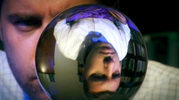|
Nature-Harnessing
How cultural evolution shapes artifacts like language and the arts to be a good fit for the human brain. In particular, how it often shapes the artifacts to mimic facets of nature, thereby co-opting -- or harnessing -- brain regions for some new task they weren’t designed for. For example, my work on the evolution of writing systems, my research showing that letter shapes across writing systems have the shapes found amongst junctions in natural scenes, and how the sounds of words mimic the fundamental signature of natural events among solid objects (in Harnessed). I discuss these in my books, Vision Revolution, Harnessed, The Origin of Art (co-authors Steven Pinker, Geoffrey Miller and Brian Boyd), and Human 3.0. Visual Perception Evolution I have a variety of research contributions in visual perception, coming at it from a theoretical / evolutionary / design side. Examples include... why we have color vision (for seeing blood under the skin, for sensing emotions and state), why we see illusions (perceiving the present), why our eyes face forward (for seeing through clutter in forests), and why we like new stimuli but then get bored (concerns the optimal preference system). Also in this category might be my work showing how to trick the visual system into carrying out arbitrary computations (a fuller explanation here) Some of these research directions were talked about in my books, Brain from 25000 Feet and Vision Revolution. |
Emotional Artificial Intelligence
A first principles grand unified theory of emotional expressions. The theory makes a four-dimensional pattern of predictions concerning the structure and meaning of emotional expressions, as a poker-like signaling system allowing social animals to engage in compromise-seeking negotiation. The pattern of predictions appears to fit the actual structure and meaning of emotional expressions we possess. The power of the theory goes way beyond any to date, and I believe it is the backbone of what is needed to drive advancement in emotionally intelligent AI, and in affective computing. See Expressly Human: Decoding the Language of Emotion, and The Emotion Chip. Theoretical Morphology and Complexity I have a variety of research on why biology is structured as it is. This includes that pruney fingers have the optimal morphology for rain treads to prevent hydroplaning, how arteries and neurons are nearly volume optimal connection networks for reaching out, why the micro- and macro-anatomical properties of mammalian brains change as they do in larger brains, why animals have the number of cortical areas they do, why the visual cortex has that many levels, why animals across a dozen phyla have as many limbs and digits as they do, how behavioral complexity scales rises, and why the dictionary is organized as it is (to minimize the total number of words). Some of these appeared in my first book, The Brain from 25000 Feet. Philosophical Logic Some of my earliest work concerned logico-philosophy. I have a long contribution to Synthese on the foundations of the riddle of induction, another in Synthese on why natural language is vague, and research in this line on why eureka moments are expected for any computational agent (and an easier to read version). Some of these research areas were part of my first book, The Brain from 25000 Feet. |
